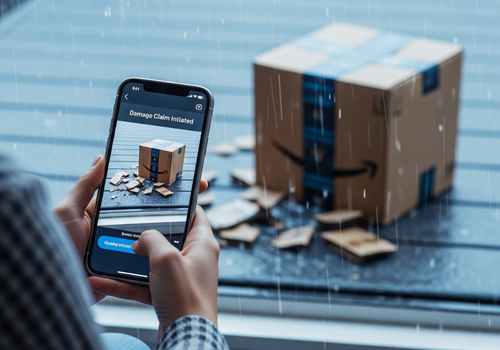Why You Keep Receiving Damaged Packages from Amazon and How to Make Sure It Doesn’t Happen Again
Why Does This Keep Happening? Common Causes Behind Damaged Deliveries
The root of repeated damaged deliveries often lies in weak packaging standards, especially when dealing with third-party sellers. Many sellers try to cut costs by using thin boxes, zero padding, or flimsy mailers—putting your product at risk from the moment it’s handed over to shipping. In some cases, items are already damaged when packed. Amazon’s massive logistics network also contributes: rushed packing at fulfillment centers, automated sortation, and last-mile delivery providers under pressure to meet quotas can lead to rough handling and product drops. Combine this with fragile items or liquid supplements, and breakage becomes almost inevitable.
Third-Party Seller Negligence: The Hidden Risk Factor
A major portion of damaged deliveries comes from unregulated third-party sellers who operate without strict quality standards. These sellers often ship products themselves instead of using Fulfillment by Amazon (FBA), meaning there’s no oversight from Amazon regarding packaging quality or shipping procedures. When sellers stuff items into random boxes without bubble wrap, separate containers, or product cushioning, even the sturdiest items can arrive broken. And worse—these sellers often refuse to take responsibility once a package is delivered, leaving you stuck with the damage and the hassle.
Fulfillment Center Overload and the Impact of Speed-First Shipping
Amazon Prime promises lightning-fast delivery, but this speed can sometimes come at the cost of care. Fulfillment centers are often overloaded, especially during sales events or holidays. Packages are processed through conveyor belts, robots, and rushed human handling. When items aren’t packaged properly at the source, this high-speed system becomes a recipe for disaster. If your item wasn’t in a padded box—or was packed with unrelated products in the same box—it’s likely to suffer during transport. The faster the system, the rougher the ride for your order.
Delivery Driver Mishandling and Poor Last-Mile Logistics
Once your product leaves the Amazon warehouse, it enters the hands of local delivery partners. In many cases, these are contracted drivers working on tight timelines. Packages are tossed into vans without regard for orientation or label instructions. Drivers sometimes drop boxes at gates, under the sun, in the rain, or even throw them over fences. Surveillance footage of careless delivery has gone viral in recent years, confirming what many buyers already suspect: once your item is out for delivery, anything can happen. Without clear handling instructions or secure outer packaging, items are especially vulnerable in this last stage.
What You Can Do Right Now to Prevent Future Package Damage
The good news? You can take steps to reduce the chances of receiving broken items from Amazon again. First, whenever possible, only buy items fulfilled by Amazon (FBA). These products are stored, packaged, and shipped by Amazon directly, ensuring more professional handling. Always check the seller information before placing an order—avoid sellers with poor packaging or damage complaints. For fragile items, request extra packaging in the order notes if available. You can also reach out to Amazon Chat Support right after ordering and ask them to add a note for careful packing. It’s not guaranteed, but it’s often honored.
How to Report and Claim Damaged Items the Right Way
If your package does arrive damaged, report it immediately. Go to your Amazon order history, click on the item, and choose “Return or Replace Items.” Upload photos showing the damage, the packaging, and shipping labels. This helps Amazon determine fault and issue a refund or replacement faster. If the seller refuses to accept responsibility, you can file an A-to-Z Guarantee claim. Always use English in messages and maintain polite but firm communication. Amazon typically sides with buyers when valid proof is presented, especially if the item was high-value or clearly mishandled.
Leave Product Feedback and Packaging Reviews to Help Others
You can also make an impact by leaving detailed reviews about poor packaging. On the product review page, include a section that focuses on the condition of the item upon delivery and how it was packed. This helps other buyers avoid the same seller, puts pressure on Amazon to enforce better packaging standards, and alerts the seller to fix their shipping practices. The more buyers report packaging damage publicly, the more sellers will be held accountable for taking better care in the future.
Get Amazon to Flag Repeated Seller Violations
If you notice the same seller causing issues repeatedly—or multiple reviewers complaining about damaged packages—you can flag the seller directly. Use Amazon’s “Report Incorrect Product Information” or “Report a Violation” tools. You can also contact Amazon Customer Support via chat and ask for a quality review of that seller’s fulfillment process. With enough reports, Amazon may restrict or suspend the seller’s account. This is especially important for categories like health supplements, electronics, and baby products, where safety is non-negotiable.
Conclusion: Protect Your Orders, Protect Your Wallet
Broken, crushed, or leaking Amazon packages can quickly turn a good deal into a frustrating ordeal. But you don’t have to keep tolerating damaged goods and unresponsive sellers. In 2025, the key is being proactive: choose FBA products, check seller reviews, document everything, and escalate issues quickly when needed. Use your voice through reviews and reports to push for better packaging standards across Amazon. As a consumer, you have the right to receive your items safely and intact. The more informed and prepared you are, the less likely you’ll be stuck with a damaged delivery—and the more control you’ll have over your Amazon shopping experience.

